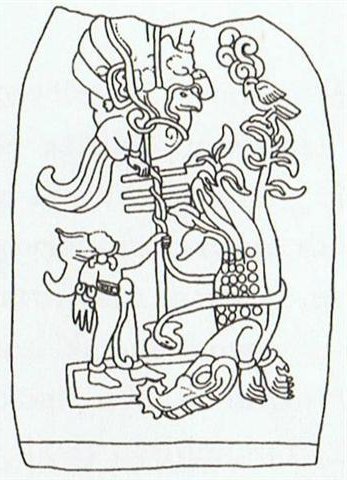7. The distance from Hawaii to the northwest coast of the American contintent is not far, which could help to explain the common notion of eating an eye at new year: ... the renewal of kingship at the climax of the Makahiki coincides with the rebirth of nature. For in the ideal ritual calendar, the kali'i battle follows the autumnal appearance of the Pleiades, by thirty-three days - thus precisely, in the late eighteenth century, 21 December, the winter solstice. The king returns to power with the sun. Whereas, over the next two days, Lono plays the part of the sacrifice. The Makahiki effigy is dismantled and hidden away in a rite watched over by the king's 'living god', Kahoali'i or 'The-Companion-of-the-King', the one who is also known as 'Death-is-Near' (Koke-na-make). Close kinsman of the king as his ceremonial double, Kahoali'i swallows the eye of the victim in ceremonies of human sacrifice ... ... The Raven stole the skin and form of the newborn child. Then he began to cry for solid food, but he was offered only mother's milk. That night, he passed through the town stealing an eye from each inhabitant. Back in his foster parents' house, he roasted the eyes in the coals and ate them, laughing. Then he returned to his cradle, full and warm. He had not seen the old woman watching him from the corner - the one who never slept and who never moved because she was stone from the waist down. Next morning, amid the wailing that engulfed the town, she told what she had seen. The one-eyed people of the sky dressed in their dancing clothes, paddled the child out to mid-heaven in their canoe and pitched him over the side ... The eye and the egg are symbols of each other by cause of their common form. By swallowing an eye from each one of the sky village inhabitants the newborn child (Raven) turns them from a people with the normal 2 eyes into a people with single eyes, into cyclopes. A cyclope corresponds to other assymmetrically handicapped persons in myth. I guess the sky is the 'cap' and that 'handicap' once meant to have lost a hand, i.e. to be formed like the people in the upper world, above the sky dome. For an example we can look at the deformed arm of one of the Hero Twins, an arm which is hanging down with 3 'fingers' in the picture below (from David Freidel, Linda Schele, Joy Parker: Maya Cosmos. Three Thousand Years on the Shaman's Path.):
"... This 'crocodile tree' is a very ancient image among the Maya and is featured in Popol Vuh version of Creation. In fact, a monument from the very early ceremonial center of Izapa in Chiapas shows this crocodile tree along with a picture of one of the Hero Twins after his arm has been ripped off in a struggle with Itzam-Yeh, the Classic name for Seven-Macaw. With his good arm he is holding a pole on which a Late Preclassic-period version of Itzam-Yeh perches ..." With one hand lost there will be only 5 fingers remaining, symbolizing the 'fire' in the sky. Mars, the fiery red planet, has one strong 'eye' (when Mars is close to Earth) and one weak 'eye' (when he is distant). Once these components in his character - red like fire and one weak side - ought to have decided (permanently) his location to be in spring. The ceremonial center of Izapa should be their place for 'the egg', their raaraa: ... The chief thus makes his appearance at Lakeba from the sea, as a stranger to the land. Disembarking at the capital village of Tubou, he is led first to the chiefly house (vale levu) and next day to the central ceremonial ground (raaraa) of the island ... And I decide to change my interpretation of the glyph type raaraa from 'inundated land' to a 'pole':
Presumably we can connect the pair 'pole' (male) and 'egg' (female) with winter solstice:
The old woman in the corner, stone from the waist down, could correspond to my Rogo glyph type:
Winter solstice could have been regarded as 8 nights long (equal to the stretch of time when Venus is invisible):
There are 392 glyphs on side a of the Mamari tablet, and the first glyph on side b is a raaraa glyph:
|
|||||||||||||||||||||||||||||||||||||||||||||||||||||||||||||||||||||
